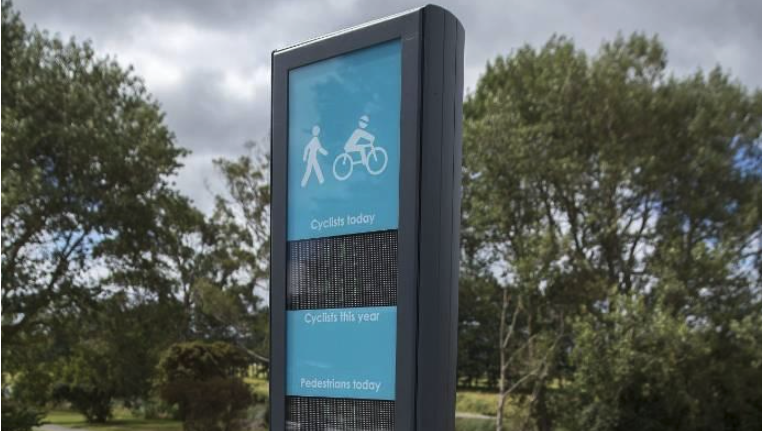Award
Walking and Public transport initiative
Winner
Be Counted at PN City He Ara Kotahi Bridge by Palmerston North City Council
In brief
The CITX-3D is a patented camera with the capacity to count and classify pedestrians, bicycles and vehicles in the busiest of urban areas. In December 2019 Palmerston North was the first New Zealand council to install a combined pedestrian and bike counter and display. It is on He Ara Kotahi Bridge.
The detail
(From the nomination form)
 Unless we know how many people are walking along a footpath or crossing at a junction or using a shared path, it’s difficult to assess the success of rule changes or physical interventions. Counting people on foot has traditionally been done by hand by students with a clicker which is expensive, inaccurate if there are crowds and therefore done less frequently than desirable and then for less than 24/7. Automated counters on single file trails have been around for a while but until recently didn’t distinguish between users. The technical challenge of automatically counting pedestrians has needed significant progress in artificial intelligence to distinguish between shadows, bikes and people. Pedestrians come in all sizes and speeds. The CITX-3D appears to solve these problems of recognition and will give us much better data.
Unless we know how many people are walking along a footpath or crossing at a junction or using a shared path, it’s difficult to assess the success of rule changes or physical interventions. Counting people on foot has traditionally been done by hand by students with a clicker which is expensive, inaccurate if there are crowds and therefore done less frequently than desirable and then for less than 24/7. Automated counters on single file trails have been around for a while but until recently didn’t distinguish between users. The technical challenge of automatically counting pedestrians has needed significant progress in artificial intelligence to distinguish between shadows, bikes and people. Pedestrians come in all sizes and speeds. The CITX-3D appears to solve these problems of recognition and will give us much better data.
Other shared facilities such as Hutt Road in Wellington, only have bike counters and many people are under the erroneous impression that technology to reliably count people on foot is not yet available.
This counter was required by NZTA for He Ara Kotahi and Be Counted Technology Ltd is on their preferred supplier list. The installation, including camera and display, cost $40,000 and the overall project cost $19 million. The counter showed planners’ expectations of 1000 users a day was valid. The counter displays real-time information and also transmits data, showing the busiest times of day.
Since the system uses thermal imaging to detect people, there is no infringement on privacy.
Measurement. By 5pm on Thursday, January 16, after about a month in use, the display board was showing 359 cyclists and 617 walkers for the day, and 8092 cyclists and 21,896 pedestrians since it started recording.
Success. It’s a refreshing change to see people on foot counted as well as cyclists. Planners predicted a thousand users a day and the 33000 in a month are confirmation of that prediction. Often projects for active transport alone are seen as optional extras. The counter makes the investment in He Ara Kotahi easy to justify. The numbers show that 73% of users are people on foot and 27% are on cycles. This is a salutary reminder that while shared facilities are often described in shorthand as being for cyclists, there are sometimes many more walkers. This has implications for design of separated rather than shared paths in the future. It’s also useful data to see whether we can collectively succeed in increasing the numbers using both modes rather than one at the expense of the other.
The overall project cost $19 million, with $7 million being PNCC’s contribution. The display and detection system are thus 0.21% of the project. Detection at least should be a requirement for most infrastructure changes.
Potential applicability of initiative to other locations or organisations. The camera is applicable to many situations in New Zealand. As it is movable and only requires a 12V supply it can be used to assess which are the busiest intersections, which junctions require longer or more frequent pedestrian phases at traffic lights (probably most of them!). It can be used to show before and after numbers and the success or failure of removing parking or improving the streetscape, even with short term interventions such as those catalysed by the Innovating Streets Fund.
The display is more expensive and takes up room on walking or cycling infrastructure but can be a useful signal that infrastructure is making a difference. People often undercount walkers and cyclists because we take up far less room than in a car. Additionally, where there is a shared path, a counter that shows both modes could modify user behaviour and potentially justify a wider space that caters for separate infrastructure rather than continuing to reserve scarce space for parked or moving cars.
If we don’t count people on foot, their needs will be ignored. Any shared path should always count both people on foot and people on cycles or the impression that a shared path is only for cyclists will be strengthened. Displaying the numbers crossing on foot vs numbers in cars might help motorists be kinder and more patient at traffic lights when they realise the relative numbers.
The counter and display could usefully show the relative numbers of pedestrians, cyclists and motorists on some arterial routes and reallocate space accordingly. Some further analysis of including public transport numbers from technology on buses could be valuable.
This CITIX-3D camera and display is the first to detect and display pedestrians as well as cyclists. The technology is very innovative.
